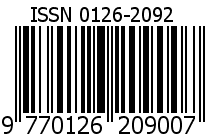Interferensi Hematokrit Tinggi Terhadap Pemeriksaan Prothrombin Time dan Activated Partial Thromboplastin Time
Abstract
Pendahuluan: Hematokrit (Ht) yang tinggi merupakan salah satu faktor interferensi pemeriksaan hemostasis yang sering luput dari perhatian. Penurunan volume plasma relatif terhadap keseluruhan darah pada hematokrit yang tinggi akan meningkatkan rasio antikoagulan terhadap plasma sehingga menyebabkan pemanjangan palsu hasil pemeriksaan prothrombin time (PT) dan activated partial thromboplastin time (aPTT). Rasio antikoagulan natrium sitrat terhadap darah pada pemeriksaan hemostasis adalah 1:9 yang efektif pada Ht ≤55%. Penyesuaian jumlah antikoagulan pada Ht >55% direkomendasikan berdasarkan pedoman Clinical and Laboratory Standards Institute (CLSI); Kasus: Sampel darah anak laki-laki 7 tahun dengan keterangan klinik penyakit jantung bawaan sianotik datang untuk pemeriksaan hematologi dan hemostasis. Pemeriksaan hematologi didapatkan Hb 23,4 g/dL dan Ht 76%. Pemeriksaan hemostasis didapatkan hasil PT dan APTT memanjang, INR meningkat (PT 25,7 detik; INR 2,36 dan aPTT 51,6 detik). Pemeriksaan hemostasis setelah dilakukan penyesuaian jumlah antikoagulan berdasarkan nilai hematokrit (natrium sitrat 0,09 mL) didapatkan hasil PT, aPTT dan INR dalam batas normal (PT 12,2 detik; INR 1,13 dan aPTT 38,1 detik). Nilai rujukan PT 10,1-13,5 detik; INR <1,2 dan aPTT 33,2-43,0 detik; Kesimpulan: Pemeriksaan PT dan aPTT pada nilai Ht >55% memerlukan penyesuaian jumlah antikoagulan untuk menjamin hasil pemeriksaan yang akurat.
Keywords
Full Text:
PDFReferences
Lippi G and Favaloro E.J. Chapter 2. Preanalytical Issues in Hemostasis and Thrombosis Testing in Hemostasis and Thrombosis: Methods and Protocols. 2017; p: 29-42.
Magnette A, Chatelain M, Chatelain B, Ten Cate H, Mullier F. Pre-analytical Issues in The Haemostasis Laboratory: Guidance for The Clinical Laboratories. Thrombosis Journal. 2016.; p:14:49.
Lippi G, Salvagno GL, Montagna M, Lima-Oliveira G, Guidi GC and Favaloro EJ. Quality Standards for Sample Collection in Coagulation Testing. Seminars in Thrombosis and Hemostasis. New York: Thieme Medical Publishers. 2012. 38 (6); p: 565-75.
Favaloro EJ, Funk DM, Lippi G. Pre-analytical Variables in Coagulation Testing Associated With Diagnostic Errors in Hemostasis. Seminars in Thrombosis and Hemostasis. 2012; 34 (7); p:612-630.
Fritsma G. Chapter 41. Laboratory Evaluation of Hemostasis in Rodak’s Hematology Clinical Principles and Applications 6th edition. Missouri: Elsevier. 2020; p: 765-792.
Arkin CF, Adcock DM, Ernst DJ, Marlar RA, Parish GT, Szamozi DI, et al. Collection, Transport, and Processing of Blood Specimens for Testing Plasma-Based Coagulation Assays and Molecular Hemostasis Assays: Approved Guideline. 5th Edition. Clinical and Laboratory Standards Institute Document H21-A5. 2008.
Turgeon ML. Chapter 1. Safety and Quality in the Hematology Laboratory in Clinical Hematology Theory and Procedure 5th Edition. Philadelphia: Lippincott William & Wilkins. 2012; p: p26-27.
Plebani M, Favaloro EJ, and Lippi G. Patient Safety and Quality in Laboratory and Hemostasis Testing: A Renewed Loop?. Seminars in Thrombosis and Hemostasis. New York: Thieme Medical Publishers. 2012. 38 (6); p: 553-558.
Keohane C, McMullin MF, Harrison C. The Diagnosis and Management of Erythrocytosis. British Medical Journal. 2013. 347 (16667); p: 1-6.
Silva VM, Rezende DC, Garcia ES, Cavalheiro C, and Strunz CC. Effect of Anticoagulant Adjustment on Prothrombin Time Test Using Two Different PT Reagents in Patients with Elevated Hematocrit. Practical Laboratory Medicine. Sao Paolo: Elsevier. 2020. 22 (e00177); p: 1-4.
Keohane EM. Chapter 1. An Overview of Clinical Laboratory Hematology in Rodak’s Hematology Clinical Principles and Applications 6th edition. Missouri: Elsevier. 2020; p: 1-7.
Schreijer AJM, Reitsma PH, Cannegieter SC. High Hematocrit as A Risk Factor for Venous Thrombosis. Cause or Innocent Bystander. Netherlands: Haematologica. 2010. 95(2); p: 182-184.
Pikta M, Zolotarerav, Vaide L, Laane E, Kleinson I, Pulk R et al. Pre-analytical Variables in Coagulation Testing: Focus on High Hematocrit. 2017. DOI: 10.13140/RG.2.2.31475.43045.





















